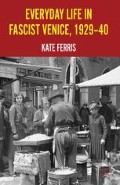Abstract
The arrival of war in Europe in September 1939 — and to Fascist Italy in June 1940 — touched Venetians in manifold ways, changing both nothing and everything. On the one hand, unlike during the first global conflict of the century, Venice was relatively removed from front-line fighting and an unspoken agreement between the allies that Venice should be considered città-franca ensured that the city’s artistic and architectural patrimony — and also, therefore, its inhabitants — would not this time be threatened by aerial bombardment. B.M. recalled the local response to the sounding of the air-raid siren: ‘the alarm sounds, but in Venice people are almost untroubled. Who would dare to throw bombs on this marvel of a city?’89 As such, the city became a leave-time destination of choice for Axis soldiers and, after September 1943, home to numerous ministries, semi-state bodies and diplomatic missions of the Repubblica Sociale Italiana [RSI: Italian Social Republic].90 The presence of civil servants, soldiers on leave, Cinecittà actors transferred from Rome to the safety of the Biennale pavilions at the Giardini, mockingly renamed Cinevillaggio, and not a few obstinate holidaymakers, all looking for the worldly entertainments for which Venice and the Lido were so renowned, conferred upon the war-time city the ‘aura of Casablanca’.91
Access this chapter
Tax calculation will be finalised at checkout
Purchases are for personal use only
Preview
Unable to display preview. Download preview PDF.
Notes
P. Corner (2002) ‘Italian Fascism: Whatever happened to dictatorship?’ Journal of Modern History 74.2, pp. 325–51.
The quotation is from R. Ben Ghiat ‘Review of L. La Rovere (2003) Storia dei GUF. Organizzazione, politica e miti della gioventù universitaria fascista 1919–1943 (Turin: Bollati Boringhieri) in the Journal of Modern Italian Studies vol. 9.2, 2004.
Author information
Authors and Affiliations
Copyright information
© 2012 Kate Ferris
About this chapter
Cite this chapter
Ferris, K. (2012). Epilogue and conclusion. In: Everyday Life in Fascist Venice, 1929–40. Palgrave Macmillan, London. https://doi.org/10.1057/9781137265081_7
Download citation
DOI: https://doi.org/10.1057/9781137265081_7
Publisher Name: Palgrave Macmillan, London
Print ISBN: 978-1-349-31311-2
Online ISBN: 978-1-137-26508-1
eBook Packages: Palgrave History CollectionHistory (R0)

